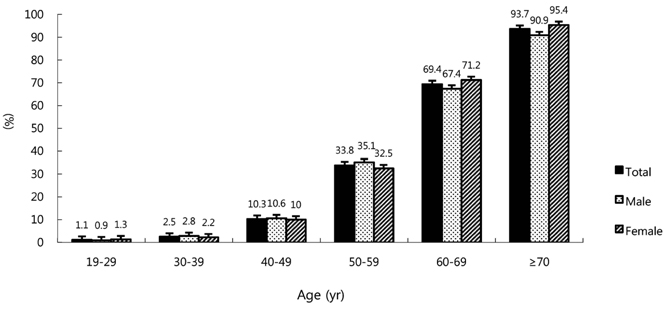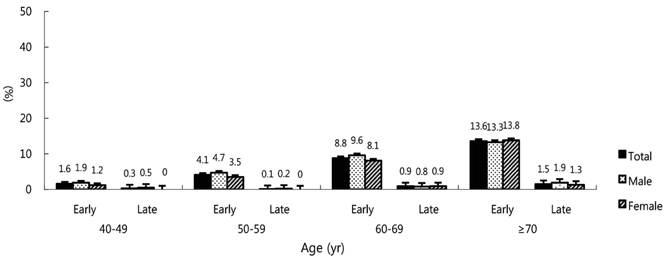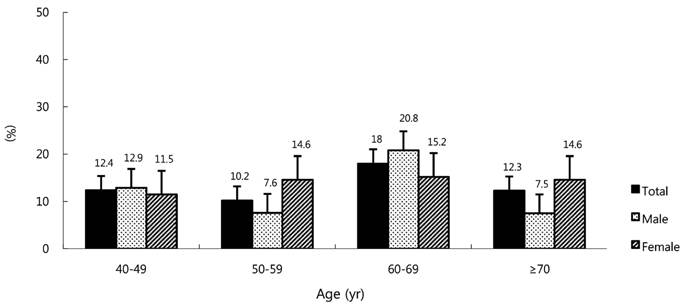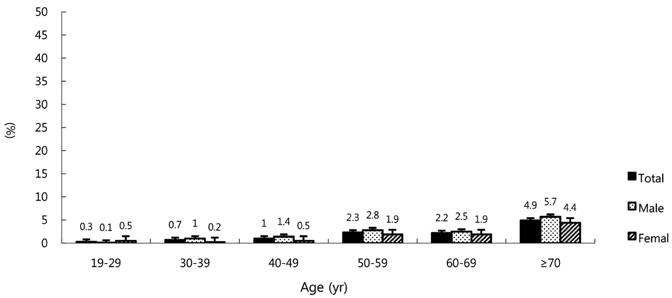Prevalence of Eye Diseases in South Korea: Data from the Korea National Health and Nutrition Examination Survey 2008-2009
- Affiliations
-
- 1Department of Ophthalmology, Chonnam National University Hospital, Chonnam National University Medical School, Gwangju, Korea.
- 2Department of Ophthalmology, Wonkwang University College of Medicine, Iksan, Korea.
- 3Department of Ophthalmology, Korea University College of Medicine, Ansan, Korea.
- 4Institute of Vision Research, Department of Ophthalmology, Yonsei University College of Medicine, Seoul, Korea.
- 5Department of Ophthalmology, Seoul National University College of Medicine, Seoul, Korea.
- 6Department of Ophthalmology, Cheil Eye Hospital, Daegu, Korea.
- 7Department of Ophthalmology, Kim's Eye Hospital, Konyang University College of Medicine, Seoul, Korea.
- 8Department of Ophthalmology, Kangbuk Samsung Hospital, Sungkyunkwan University School of Medicine, Seoul, Korea.
- 9Department of Ophthalmology, Kyungpook National University School of Medicine, Daegu, Korea.
- 10Department of Ophthalmology, The Catholic University of Korea College of Medicine, Seoul, Korea.
- 11Department of Ophthalmology, Kyung Hee University School of Medicine, Seoul, Korea.
- 12Department of Ophthalmology, Pusan National University College of Medicine, Busan, Korea.
- 13Department of Ophthalmology, Ewha Womans University School of Medicine, Seoul, Korea.
- 14Division of Chronic Disease Surveillance, Korea Centers for Disease Control & Prevention, Seoul, Korea. kwoh27@korea.kr
- 15Department of Ophthalmology, Samsung Medical Center, Sungkyunkwan University School of Medicine, Seoul, Korea. swkang@skku.edu
- KMID: 1031190
- DOI: http://doi.org/10.3341/kjo.2011.25.6.421
Abstract
- PURPOSE
The aim of this study is to report on preliminary data regarding the prevalence of major eye diseases in Korea.
METHODS
We obtained data from the Korea National Health and Nutrition Examination Survey, a nation-wide cross-sectional survey and examinations of the non-institutionalized civilian population in South Korea (n = 14,606), conducted from July 2008 to December 2009. Field survey teams included an ophthalmologist, nurses, and interviewers, traveled with a mobile examination unit and performed interviews and ophthalmologic examinations.
RESULTS
The prevalence of visual impairment, myopia, hyperopia and astigmatism in participants over 5 years of age was 0.4 +/- 0.1%, 53.7 +/- 0.6%, 10.7 +/- 0.4%, and 58.0 +/- 0.6%, respectively. The prevalence of strabismus and blepharoptosis in participants over 3 years of age was 1.5 +/- 0.1% and 11.0 +/- 0.8%, respectively. In participants over 40 years of age, the prevalence of cataract, pterygium, early and late age-related macular degeneration, diabetic retinopathy and glaucoma was 40.2 +/- 1.3%, 8.9 +/- 0.5%, 5.1 +/- 0.3%, 0.5 +/- 0.1%, 13.4 +/- 1.5%, and 2.1 +/- 0.2%, respectively.
CONCLUSIONS
This is the first nation-wide epidemiologic study conducted in South Korea for assessment of the prevalence of eye diseases by both the Korean Ophthalmologic Society and the Korea Center for Disease Control and Prevention. This study will provide preliminary information for use in further investigation, prevention, and management of eye diseases in Korea.
Keyword
MeSH Terms
Figure
Cited by 21 articles
-
Changes in Angular Deviations under General Anesthesia for Strabismus Surgery with Objective Anesthetic Depth Control
Chang Zoo Kim, Ki Yup Nam, Seung Uk Lee, Sang Joon Lee
J Korean Ophthalmol Soc. 2018;59(9):848-853. doi: 10.3341/jkos.2018.59.9.848.Thyroid Abnormality and Dry Eye Syndrome: a Cross-sectional Study from the Republic of Korea
Yeseul Kim, Jin Kwon Chung, Si Hyung Lee
J Korean Ophthalmol Soc. 2019;60(8):725-730. doi: 10.3341/jkos.2019.60.8.725.Socioeconomic Costs of Age-related Macular Degeneration in Korea
Yongsun Ahn, Donghyun Jee
J Korean Ophthalmol Soc. 2019;60(8):765-772. doi: 10.3341/jkos.2019.60.8.765.Association between Three Heavy Metals and Dry Eye Disease in Korean Adults: Results of the Korean National Health and Nutrition Examination Survey
Sang Joon Jung, Si Hyung Lee
Korean J Ophthalmol. 2019;33(1):26-35. doi: 10.3341/kjo.2018.0065.Epidemiological Survey Regarding Cataract Awareness in Korea: KNHANES IV
Tyler Hyung Taek Rim, Sun Yung Park, Tae-im Kim
J Korean Ophthalmol Soc. 2013;54(1):72-77. doi: 10.3341/jkos.2013.54.1.72.The Effect of Simvastatin on the Expression of Catalase in Human Retinal Pigment Epithelial Cells
Min Gu Kang, So Young Lee, Hee Seung Chin
J Korean Ophthalmol Soc. 2014;55(10):1535-1542. doi: 10.3341/jkos.2014.55.10.1535.Short-Term Result of Triple Procedure in Pterygium Surgery
Yong Joon Kim, Jin Kwon Chung
J Korean Ophthalmol Soc. 2014;55(3):354-360. doi: 10.3341/jkos.2014.55.3.354.The Effects of Part-Time Occlusion Therapy Shortened to One or Two Hours in Intermittent Exotropia
Kyung Ho Lee, Young Woo Suh, Yoon Ae Cho
J Korean Ophthalmol Soc. 2014;55(4):585-589. doi: 10.3341/jkos.2014.55.4.585.Clinical Features of Patients Complaining of Visual Symptoms and Diagnosed with Migraine
Joong Sik Koh, Seong Joon Kim
J Korean Ophthalmol Soc. 2015;56(12):1933-1938. doi: 10.3341/jkos.2015.56.12.1933.Outpatient Distribution for Glaucoma Evaluation
Ka Hee Park, So Yeon Lee, Young Jae Hong
J Korean Ophthalmol Soc. 2015;56(3):388-395. doi: 10.3341/jkos.2015.56.3.388.Surgical Outcome of Primary Pterygium Excision with Conjunctival Autograft
Dong Ik Kim, Mee Kum Kim, Won Ryang Wee, Joo Youn Oh
J Korean Ophthalmol Soc. 2015;56(6):856-862. doi: 10.3341/jkos.2015.56.6.856.Preferences and Trends in the Treatment of Diabetic Retinopathy in Korea and Japan
Jung Yup Kim, Jae Pil Shin, Young Joon Jo, Tae Kwann Park, Seung Young Yu, Woo Hyok Chang, Jae Ryung Oh, Ji Eun Lee, Joo Eun Lee
J Korean Ophthalmol Soc. 2016;57(8):1248-1253. doi: 10.3341/jkos.2016.57.8.1248.Cerebrospinal Fluid Pressure and Trans-lamina Cribrosa Pressure Difference in Open-angle Glaucoma: KNHANES V
Yoon Kyung Kim, Undarmaa Tumurbaatar, Young-Hoon Ohn, Seung Joo Ha, Ka Hee Park
J Korean Ophthalmol Soc. 2016;57(9):1392-1399. doi: 10.3341/jkos.2016.57.9.1392.Expression of Nestin on Endothelial Cells and Pericytes During Retinal Vascular Development in Mouse
Jin Soo Kim, Sung Wook Park, In Young Hwang, Yong Woo Kim, Jin Hyoung Kim, Jeong Hun Kim
J Korean Ophthalmol Soc. 2016;57(3):499-506. doi: 10.3341/jkos.2016.57.3.499.An Epidemiologic Survey of Strabismus and Nystagmus in South Korea: KNHANES V
Ji Eun Lee, Chang Zoo Kim, Ki Yup Nam, Seung Uk Lee, Sang Joon Lee
J Korean Ophthalmol Soc. 2017;58(11):1260-1268. doi: 10.3341/jkos.2017.58.11.1260.Intraindividual Comparison of Visual Outcomes between Blue Light-filtering and Ultraviolet Light-filtering Intraocular Lens
Geun Young Lee, Im Gyu Kim, Sung Yu, Gwang Ja Lee, Kyoo Won Lee, Young Jeung Park
J Korean Ophthalmol Soc. 2017;58(1):34-42. doi: 10.3341/jkos.2017.58.1.34.Analysis of Fluorescein Angiography and Optical Coherence Tomography in Acute Cerebral Infarction Patients
Jung Yeob Han, Yu Cheol Kim
J Korean Ophthalmol Soc. 2017;58(8):930-936. doi: 10.3341/jkos.2017.58.8.930.Association between Psychological Stress and Glaucoma: Korea National Health and Nutritional Examination Survey 2008–2012
Ilyung Jung, Jin Woo Kwon, Jin A Choi, Donghyun Jee
J Korean Ophthalmol Soc. 2018;59(8):745-751. doi: 10.3341/jkos.2018.59.8.745.Current Challenges in Diabetic Retinopathy: Are We Really Doing Better?
Jae Hyuck Lee, Su Jeong Song
Endocrinol Metab. 2016;31(2):254-257. doi: 10.3803/EnM.2016.31.2.254.Prevalence and Factors Associated with the Use of Eye Care Services in South Korea: Korea National Health and Nutrition Examination Survey 2010–2012
Yong Seok Park, Hwan Heo, Byeong Jin Ye, Young-Woo Suh, Seung-Hyun Kim, Shin Hae Park, Key Hwan Lim, Sung Jin Lee, Song Hee Park, Seung-Hee Baek,
Korean J Ophthalmol. 2017;31(1):58-70. doi: 10.3341/kjo.2017.31.1.58.The Efficacy of Fibroblast Growth Factor for the Treatment of Chronic Vocal Fold Scarring: From Animal Model to Clinical Application
Myung Jin Ban, Jae Hong Park, Jae Wook Kim, Ki Nam Park, Jae Yong Lee, Hee Kyung Kim, Seung Won Lee
Clin Exp Otorhinolaryngol. 2017;10(4):349-356. doi: 10.21053/ceo.2016.00941.
Reference
-
1. Congdon NG, Friedman DS, Lietman T. Important causes of visual impairment in the world today. JAMA. 2003. 290:2057–2060.2. Song SJ, Youm DJ, Chang Y, Yu HG. Age-related macular degeneration in a screened South Korean population: prevalence, risk factors, and subtypes. Ophthalmic Epidemiol. 2009. 16:304–310.3. Kim JH, Kang SY, Kim NR, et al. Prevalence and characteristics of glaucoma among Korean adults. Korean J Ophthalmol. 2011. 25:110–115.4. Kim H, Joo CK. The prevalence and demographic characteristics of anterior polar cataract in a hospital-based study in Korea. Korean J Ophthalmol. 2008. 22:77–80.5. Klein R, Klein BE, Lee KE, et al. Changes in visual acuity in a population over a 10-year period: the Beaver Dam Eye Study. Ophthalmology. 2001. 108:1757–1766.6. Klein R, Klein BE, Linton KL. Prevalence of age-related maculopathy. The Beaver Dam Eye Study. Ophthalmology. 1992. 99:933–943.7. Rahmani B, Tielsch JM, Katz J, et al. The cause-specific prevalence of visual impairment in an urban population. The Baltimore Eye Survey. Ophthalmology. 1996. 103:1721–1726.8. Munoz B, West SK, Rubin GS, et al. Causes of blindness and visual impairment in a population of older Americans: the Salisbury Eye Evaluation Study. Arch Ophthalmol. 2000. 118:819–825.9. Varma R, Paz SH, Azen SP, et al. The Los Angeles Latino Eye Study: design, methods, and baseline data. Ophthalmology. 2004. 111:1121–1131.10. Congdon N, O'Colmain B, Klaver CC, et al. Causes and prevalence of visual impairment among adults in the United States. Arch Ophthalmol. 2004. 122:477–485.11. Congdon N, Vingerling JR, Klein BE, et al. Prevalence of cataract and pseudophakia/aphakia among adults in the United States. Arch Ophthalmol. 2004. 122:487–494.12. Friedman DS, O'Colmain BJ, Muin BE, et al. Prevalence of cataract and pseudophakia/aphakia among adults in the United States. Arch Ophthalmol. 2004. 122:564–572.13. Kempen JH, O'Colmain BJ, Leske MC, et al. The prevalence of diabetic retinopathy among adults in the United States. Arch Ophthalmol. 2004. 122:552–563.14. Zhang X, Saaddine JB, Chou CF, et al. Prevalence of diabetic retinopathy in the United States, 2005-2008. JAMA. 2010. 304:649–656.15. Vingerling JR, Hofman A, Grobbee DE, de Jong PT. Age-related macular degeneration and smoking. The Rotterdam Study. Arch Ophthalmol. 1996. 114:1193–1196.16. Buch H, Vinding T, la Cour M, et al. Risk factors for age-related maculopathy in a 14-year follow-up study: the Copenhagen City Eye Study. Acta Ophthalmol Scand. 2005. 83:409–418.17. Buch H, Nielsen NV, Vinding T, et al. 14-Year incidence, progression, and visual morbidity of age-related maculopathy: the Copenhagen City Eye Study. Ophthalmology. 2005. 112:787–798.18. Mitchell P, Wang JJ, Smith W, Leeder SR. Smoking and the 5-year incidence of age-related maculopathy: the Blue Mountains Eye Study. Arch Ophthalmol. 2002. 120:1357–1363.19. Mitchell P, Wang JJ, Foran S, Smith W. Five-year incidence of age-related maculopathy lesions: the Blue Mountains Eye Study. Ophthalmology. 2002. 109:1092–1097.20. Livingston PM, Carson CA, Stanislavsky YL, et al. Methods for a population-based study of eye disease: the Melbourne Visual Impairment Project. Ophthalmic Epidemiol. 1994. 1:139–148.21. McCarty CA, Fu CL, Taylor HR. Epidemiology of pterygium in Victoria, Australia. Br J Ophthalmol. 2000. 84:289–292.22. Yamamoto T, Iwase A, Araie M, et al. The Tajimi Study report 2: prevalence of primary angle closure and secondary glaucoma in a Japanese population. Ophthalmology. 2005. 112:1661–1669.23. Iwase A, Suzuki Y, Araie M, et al. The prevalence of primary open-angle glaucoma in Japanese: the Tajimi Study. Ophthalmology. 2004. 111:1641–1648.24. Miyazaki M, Kubota T, Kubo M, et al. The prevalence of pseudoexfoliation syndrome in a Japanese population: the Hisayama Study. J Glaucoma. 2005. 14:482–484.25. Yamada M, Hiratsuka Y, Roberts CB, et al. Prevalence of visual impairment in the adult Japanese population by cause and severity and future projections. Ophthalmic Epidemiol. 2010. 17:50–57.26. Kawasaki R, Wang JJ, Ji GJ, et al. Prevalence and risk factors for age-related macular degeneration in an adult Japanese population: the Funagata Study. Ophthalmology. 2008. 115:1376–1381.27. Foster PJ, Oen FT, Machin D, et al. The prevalence of glaucoma in Chinese residents of Singapore: a cross-sectional population survey of the Tanjong Pagar district. Arch Ophthalmol. 2000. 118:1105–1111.28. Seah SK, Wong TY, Foster PJ, et al. Prevalence of lens opacity in Chinese residents of Singapore: the tanjong pagar survey. Ophthalmology. 2002. 109:2058–2064.29. Lamoureux EL, Chong E, Wang JJ, et al. Visual impairment, causes of vision loss, and falls: the singapore malay eye study. Invest Ophthalmol Vis Sci. 2008. 49:528–533.30. Foong AW, Saw SM, Loo JL, et al. Rationale and methodology for a population-based study of eye diseases in Malay people: The Singapore Malay eye study (SiMES). Ophthalmic Epidemiol. 2007. 14:25–35.31. Xu L, Wang Y, Li Y, et al. Causes of blindness and visual impairment in urban and rural areas in Beijing: the Beijing Eye Study. Ophthalmology. 2006. 113:1134.e1–1134.e11.32. Li Y, Xu L, Jonas JB, et al. Prevalence of age-related maculopathy in the adult population in China: the Beijing Eye Study. Am J Ophthalmol. 2006. 142:788–793.33. Xu L, Li Y, Wang S, et al. Characteristics of highly myopic eyes: the Beijing Eye Study. Ophthalmology. 2007. 114:121–126.34. You Q, Xu L, Jonas JB. Prevalence and associations of epiretinal membranes in adult Chinese: the Beijing Eye Study. Eye (Lond). 2008. 22:874–879.35. Liang YB, Friedman DS, Wong TY, et al. Rationale, design, methodology, and baseline data of a population-based study in rural China: the Handan Eye Study. Ophthalmic Epidemiol. 2009. 16:115–127.36. Jin YH. A new logMAR vision chart: Jin's Vision Chart. J Korean Ophthalmol Soc. 1997. 38:2036–2044.37. Van Herick W, Shaffer RN, Schwartz A. Estimation of width of angle of anterior chamber. Incidence and significance of the narrow angle. Am J Ophthalmol. 1969. 68:626–629.38. Tan DT, Chee SP, Dear KB, Lim AS. Effect of pterygium morphology on pterygium recurrence in a controlled trial comparing conjunctival autografting with bare sclera excision. Arch Ophthalmol. 1997. 115:1235–1240.39. Bird AC, Bressler NM, Bressler SB, et al. The International ARM Epidemiological Study Group. An international classification and grading system for age-related maculopathy and age-related macular degeneration. Surv Ophthalmol. 1995. 39:367–374.40. Diabetic Retinopathy Study Coordinating Center. Diabetic Retinopathy Study: mannual of operations. 1972. Baltimore: Diabetic Retinopathy Study Coordinating Center.41. Early Treatment Diabetic Retinopathy Study Research Group. Grading diabetic retinopathy from stereoscopic color fundus photographs: an extension of the modified Airlie House classification. ETDRS report number 10. Ophthalmology. 1991. 98:5 Suppl. 786–806.42. Klein R, Klein BE, Moss SE, Cruickshanks KJ. The Wisconsin Epidemiologic Study of diabetic retinopathy. XIV. Ten-year incidence and progression of diabetic retinopathy. Arch Ophthalmol. 1994. 112:1217–1228.43. Klein R, Klein BE, Moss SE, Cruickshanks KJ. The Wisconsin Epidemiologic Study of Diabetic Retinopathy: XVII. The 14-year incidence and progression of diabetic retinopathy and associated risk factors in type 1 diabetes. Ophthalmology. 1998. 105:1801–1815.44. Foster PJ, Buhrmann R, Quigley HA, Johnson GJ. The definition and classification of glaucoma in prevalence surveys. Br J Ophthalmol. 2002. 86:238–242.45. Kempen JH, Mitchell P, Lee KE, et al. The prevalence of refractive errors among adults in the United States, Western Europe, and Australia. Arch Ophthalmol. 2004. 122:495–505.46. Wong TY, Foster PJ, Hee J, et al. Prevalence and risk factors for refractive errors in adult Chinese in Singapore. Invest Ophthalmol Vis Sci. 2000. 41:2486–2494.47. Shimizu N, Nomura H, Ando F, et al. Refractive errors and factors associated with myopia in an adult Japanese population. Jpn J Ophthalmol. 2003. 47:6–12.48. Sawada A, Tomidokoro A, Araie M, et al. Refractive errors in an elderly Japanese population: the Tajimi study. Ophthalmology. 2008. 115:363–370.e3.49. Gwiazda J, Scheiman M, Mohindra I, Held R. Astigmatism in children: changes in axis and amount from birth to six years. Invest Ophthalmol Vis Sci. 1984. 25:88–92.50. Mutti DO, Zadnik K. Age-related decreases in the prevalence of myopia: longitudinal change or cohort effect? Invest Ophthalmol Vis Sci. 2000. 41:2103–2107.51. Katz J, Tielsch JM, Sommer A. Prevalence and risk factors for refractive errors in an adult inner city population. Invest Ophthalmol Vis Sci. 1997. 38:334–340.52. Anton A, Andrada MT, Mayo A, et al. Epidemiology of refractive errors in an adult European population: the Segovia study. Ophthalmic Epidemiol. 2009. 16:231–237.53. Robaei D, Rose KA, Kifley A, et al. Factors associated with childhood strabismus: findings from a population-based study. Ophthalmology. 2006. 113:1146–1153.54. Preslan MW, Novak A. Baltimore Vision Screening Project. Ophthalmology. 1996. 103:105–109.55. Kvarnstrom G, Jakobsson P, Lennerstrand G. Visual screening of Swedish children: an ophthalmological evaluation. Acta Ophthalmol Scand. 2001. 79:240–244.56. Matsuo T, Matsuo C. The prevalence of strabismus and amblyopia in Japanese elementary school children. Ophthalmic Epidemiol. 2005. 12:31–36.57. Baiyeroju AM, Oluwatosin OM. Blepharoptosis in Ibadan, Nigeria. West Afr J Med. 2003. 22:208–210.58. Athanasiov PA, Casson RJ, Sullivan T, et al. Cataract in rural Myanmar: prevalence and risk factors from the Meiktila Eye Study. Br J Ophthalmol. 2008. 92:1169–1174.59. Wu K, He M, Xu J, Li S. Pterygium in aged population in Doumen County, China. Yan Ke Xue Bao. 2002. 18:181–184.60. Chen SJ, Cheng CY, Peng KL, et al. Prevalence and associated risk factors of age-related macular degeneration in an elderly Chinese population in Taiwan: the Shihpai Eye Study. Invest Ophthalmol Vis Sci. 2008. 49:3126–3133.61. Chen MS, Kao CS, Chang CJ, et al. Prevalence and risk factors of diabetic retinopathy among noninsulin-dependent diabetic subjects. Am J Ophthalmol. 1992. 114:723–730.62. Narendran V, John RK, Raghuram A, et al. Diabetic retinopathy among self reported diabetics in southern India: a population based assessment. Br J Ophthalmol. 2002. 86:1014–1018.63. Rema M, Premkumar S, Anitha B, et al. Prevalence of diabetic retinopathy in urban India: the Chennai Urban Rural Epidemiology Study (CURES) eye study, I. Invest Ophthalmol Vis Sci. 2005. 46:2328–2333.64. Thylefors B, Negrel AD, Pararajasegaram R, Dadzie KY. Global data on blindness. Bull World Health Organ. 1995. 73:115–121.65. Tielsch JM, Sommer A, Katz J, et al. Racial variations in the prevalence of primary open-angle glaucoma. The Baltimore Eye Survey. JAMA. 1991. 266:369–374.66. Rahman MM, Rahman N, Foster PJ, et al. The prevalence of glaucoma in Bangladesh: a population based survey in Dhaka division. Br J Ophthalmol. 2004. 88:1493–1497.
- Full Text Links
- Actions
-
Cited
- CITED
-
- Close
- Share
- Similar articles
-
- The prevalence and risk factors for pterygium in South Korea: the Korea National Health and Nutrition Examination Survey (KNHANES) 2009-2010
- An Overview of Ophthalmologic Survey Methodology in the 2008-2015 Korean National Health and Nutrition Examination Surveys
- The Current Status and the Perspectives of Nutrition Survey
- Prevalence of Laryngeal Disease in South Korea: Data from the Korea National Health and Nutrition Examination Survey from 2008 to 2011
- An Epidemiologic Survey of Strabismus and Nystagmus in South Korea: KNHANES V








